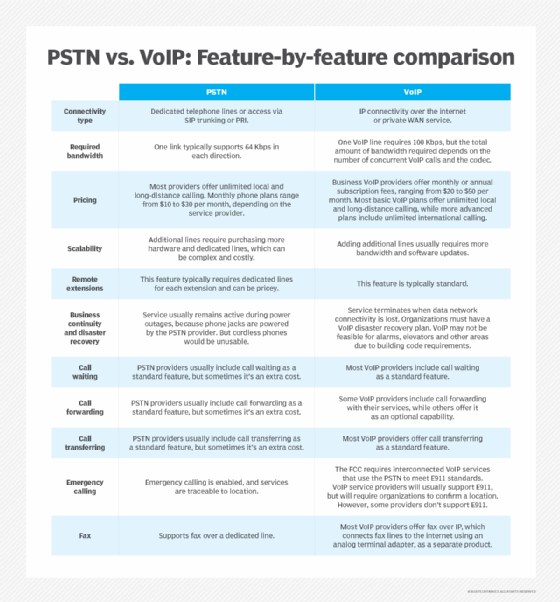What is PSTN (public switched telephone network)?
PSTN (public switched telephone network) is the world's collection of interconnected voice-oriented public telephone networks via traditional circuit-switched networks. Also known as landlines, Plain Old Telephone Service or fixed-line telephones, PSTN comprises all the switched telephone networks worldwide operated by local, national or international carriers. These networks provide the infrastructure and services for public telecommunications.
The PSTN system has been in general use since the late 1800s, evolving from the days of Alexander Graham Bell's telephone patent. The legacy platform once used underground copper wires to provide businesses and households alike with reliable worldwide communication for generations. Today, it is almost entirely digital.
How does PSTN work?
PSTN lets users make landline telephone calls to one another. It combines multiple worldwide telephone networks, including the following:
- Telephone lines.
- Fiber optic cables.
- Switching centers.
- Cellular networks.
- Satellites.
- Cable systems.
Switches at centralized points on a network make up PSTN. These switches function as nodes to enable communication between two points on the network. After the call is routed through multiple switches, users can place a call. Voice signals then travel over the connected phone lines.
Traditional dial-up network modems also use PSTN phone lines to connect a computer to the internet. Dial-up internet connections support up to 56 kilobits per second (Kbps). In the internet's early days, this was the main method for home internet access. It became obsolete with the introduction of broadband internet services.
PSTN architecture
Traditional PSTN has a hierarchical architecture and a star structure. Individual subscriber lines connect to a local exchange, which communicates with trunk, main and central exchanges. The lines within a local exchange typically have the same area code. A user who wants to call a number outside the local exchange must add an area code. To make an international call, a user must dial the country code.
What's the difference between PSTN and ISDN?
Experts developed Integrated Services Digital Network (ISDN) for digital data and voice transmission over ordinary phone lines. ISDN provides 128 Kbps, as well as faster calls and better voice quality than PSTN. A key feature of ISDN is speech and data integration in the same line, which is unavailable with ordinary telephone wires.
While ISDN is an improvement over PSTN, both networks have become obsolete and are expected to eventually switch off in favor of newer technologies.
What's the difference between PSTN and VoIP?
Voice over Internet Protocol (VoIP) -- also known as IP telephony, broadband telephony or internet telephony -- transmits voice communication over the internet or private wide area network. VoIP eliminates the need for circuit-switched networks for phone calls.
VoIP uses codecs to turn audio into data packets and transmit them across an IP network. It then turns the packets back into audio on the receiving end of the call. Many organizations get their VoIP services from cloud unified communications (UC) providers or from VoIP providers.
VoIP has advantages over PSTN, including the following:
- Lower network infrastructure costs.
- Scalability.
- Advanced features, such as UC and app integrations.

History of PSTN
Telephone commercialization began in 1876. At that time, there were no network connections. Rather, telephones were wired in pairs for use between locations, so it wasn't possible to call more than one location. People who wanted to talk to others in different locations had to have several different telephones -- each with its own purpose. In the early days, operators connected one party to another manually.
Telephone networks expanded in the 1900s as the number of people using telephones increased. This led to the growth of PSTN, as older telephone networks used analog signaling.
However, providers began digitizing voice calls by the 1960s, and automated electronic switching replaced manual switching. This upgrade meant that digital voice signals could share the same wire with other phone calls.
Although most people associate PSTN with copper wiring, modern PSTN infrastructure also uses fiber optic cables. Today, services are increasingly digital, as new last-mile infrastructure -- such as fiber optic cables -- replaces copper lines.
Telecommunications providers are transitioning from PSTN to all-IP communications. Most carriers don't want to manage two infrastructures -- analog and digital -- when digital architecture can offer the same or better levels of service for customers.
Telecom equipment manufacturers are also phasing out analog equipment in favor of digital. This makes it increasingly difficult for carriers to maintain analog infrastructures. Digital technology enables telecom operators to offer more services, so they prefer investing in technology that might increase their revenue.
Editor's note: This definition was originally written by Linda Rosencrance and updated by TechTarget editors to improve the reader experience.







